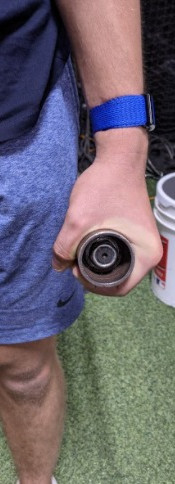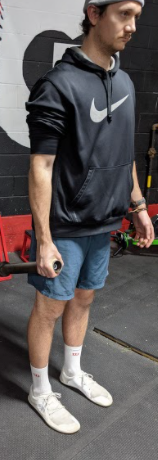If you have been staying up to date with baseball research, you probably read the 2019 article by Birfer, Sonne, and Holmes (found here) titled “Manifestations of muscle fatigue in baseball pitchers: a systematic review”. In short, they demonstrated a relationship between fatigue in baseball pitching, and three overarching outcomes: changes in kinematics, a decrease in performance, and an increase in injury risk.
It’s a must read, and further opens the door on the injury epidemic that is currently sweeping the game (It’s also authored by my friend Rich Birfer, and my current Master’s supervisors Dr. Mike Sonne, and Dr. Mike Holmes). If you are interested in this topic further I suggest you give them a follow.

This diagram found in the paper describes “the theoretical framework representing the relationship between fatigue and the three identified outcomes” (Birfer et al., 2019).
It proposes “that changes in performance likely decay at a lesser rate than changes in kinematics, suggesting that modifications to a pitcher’s kinematics are made to limit the decrements of fatigue” (Birfer et al., 2019).
It continues: “the compromise for maintaining performance is the adaptation of mechanics which could increase the risk of musculoskeletal injury, particularly with respect to the elbow and shoulder joints” (Birfer et al., 2019).
Essentially, fatigue should lead to decreased performance (think less velocity, less effective pitches), but the body will alter its kinematics and kinetics in a manner that will prolong adequate performance. It is these changes however, that could increase the risk of injury.
So, fatigue is linked with a bunch of stuff, including decreased performance and injury risk. That’s not entirely new (though this was the first sweeping review), and is something seen across various other industries.
Fatigue vs Endurance?
We need to find a way to assess fatigue without using performance as a barometer. Before we do that, we need to comment on the difference between fatigue and endurance.
Gorin et al. (2005) defines fatigue as ‘‘exercise induced reduction in maximal voluntary muscle force’’, whereas endurance is “the time period for which a constant (non-fatiguing) force output can be maintained”.
That is to say that fatigue is related to production of a maximal voluntary muscle force, while endurance is related to maintenance of sub-maximal force output across time. The paper goes on to comment that based on the above definitions, the two terms have been used interchangeably in the past.
Even in the Birfer et al. (2019) paper, they comment that fatigue is “broadly defined as a decrease in force generating capacity”, which alludes to the muddiness of the situation. What is clear is that strength, fatigue, and endurance are unequivocally intimately related with each other, and for the sake of this discussion, that’s where we will leave things.
Endurance tests
Based on the research from Gorin et al. (2005) and other studies, we know that repeated intermittent contractions cause slower loss of force than sustained contractions (i.e. less fatiguable).
See why this is convoluted?
Tests have historically used 50% of a 1RM squeeze on a dynamometer as the standard for testing grip endurance, but there is agreement that this may not be the most valid and generally requires constant stimulation from an investigator.
It just so happens that our dynamometer has been on the fritz as of late, and has been in desperate need of some batteries for the past few months. That meant finding a novel way to assess grip endurance with what we had in house.
I’ll come back to this in a bit, after a brief overview of muscle activation and co-contraction.
The importance of grip strength training with UCL pathology
Ever since this post by my mentor Dr. Steve Osterer and several subsequent late night discussions on the topic, I have been a big supporter of increased forearm flexor-pronator muscle (FDS, FCU, FCR, and PT) strength and co-contraction acting as a potential protective mechanism for the UCL. I don’t think co-contraction of those muscles is the be all and end all for UCL protection, but I do think that it helps the symptoms, aids recovery and is closely related to UCL health.
This notion also fits cohesively into the fatigue-performance diagram from the Birfer et al. (2019) article. The stronger/ more durable a tissue is, the longer that tissue is able to withstand fatigue and related performance changes.
If you want to get better at ‘X’, do ‘X’ a lot.
Grip strengthening is thus something that I reinforce when an athlete complains of both generalized elbow soreness, and/ or more UCL specific issues. Like any good therapist, after any necessary soft-tissue work (diagnosis dependent) I back up our efforts with exercise (usually with similar exercises as above, but also with full-range flexion/ extension and pronation/ supination work).
Since I have used this in rehabilitation, grip strength is something that I have also made a conscious effort to insert into my athletes programs. Active and passive hangs, adding fat gripz to a lot of dumbbell exercises, and farmers carries are all exercises that are steadfast in my programs.
A common response from the athletes who are dealing with an elbow issue is that “it feels a little more difficult on my [affected side]”. To me, that makes logical sense. Obviously, there are a ton of factors that are at play in their experience, but the same could be said for any injury in the rehab spectrum. However, athletes are usually able to hold equal weight in either hand when doing heavy grip exercises or hangs.
It might feel a little tougher but there is no added ‘pain’, and in the end they both get passing grades.
Now, back to finding a ‘test’.
One of the barriers to this was finding something that could be held for extended periods of time, but not indefinitely. Taking a page from grip training, I started with farmers carries. To fit the qualifications of the above, I had to modify to find a weight that would not fatigue the shoulder girdle before grip, and that an athlete would be able to hold for several minutes, but not forever. 100lbs would be far too heavy, and 10lbs would be far too light (for the average athlete).
To take this even further, the larger the object the more effort would be required to hold it. I also needed a way to test multiple athletes at the same time, so that it wouldn’t take all day to train and get the feedback I was after. Seeing as how we only have one set of fat gripz at our facility, I was really only left with one choice.
What I ended up with was a landmine barbell hold ‘test’, with the barbell at approximately 30-45 degrees (depending on height, and arm length). The setup can be seen below:
Instructions were simple: hold it as long as you can, then switch arms and do it on the other side.
Since trying this with an athlete who had an image-confirmed partial UCL tear, I’ve had multiple athletes perform this. Some with known elbow issues, some without. Some go throwing arm first, some go throwing arm second. Some tried it pre-throwing, and some tried it post-throwing. All athletes wrote down their experiences afterwards (after a few minutes of rest so they could hold a pen properly).
The findings are incredibly intriguing.
Before we proceed further I think it is worth mentioning:
yes - height, arm length, hand size are all going to contribute differently with different subjects
yes - there will likely be a crossover fatigue effect (CNS)
yes - hand-grip interface (how sweaty someone is/ isn’t) will likely play a role as well
What happened?
Athletes (n= 2) with image confirmed UCL pathologies demonstrate weakness and pinpoint UCL discomfort around the 8-12 minute mark in their throwing arm compared to their glove arm.
Athletes (n=2) who we suspect could have some degree of UCL pathology show similar results and complaints to those with confirmed issues.
The athletes with suspected pathology that normalize their times do not appear to develop symptoms/ have symptom resolution.
Athletes (n=6) who we do not suspect to have any degree of UCL pathology show greater throwing arm endurance than glove arm, and are capable of lasting 12+ minutes.
In general:
Around the 2 minute mark, players “could feel the weight of the bar”.
Around the 6 minute mark, players began to shake.
Between the 6-8 minute mark, most began to mention pain and weakness creeping in, either diffusely if they were not suspected of pathology, or directly if they were. It was generally minor.
From the 8-10 minute mark, a bunch of athletes actually dropped the bar from fatigue, and many athletes had intensification of their symptoms.
From the 10-12 minute mark, more intense responses than the 8-10.
Those that lasted 12+ mentioned being able to go for much longer, but either gave up or switched hands due to lack of findings.
What are my thoughts on this?
As the Birfer et al. (2019) paper said, as athletes fatigue, they start to modify their technique - which could increase stress on their forearm musculature and UCL. The more endurance strength someone has in their active tissues, then they should be able to withstand the negative impact of fatigue for longer. Someone with a compromised UCL is going to have subsequent forearm flexor-pronator endurance issues.
Training grip endurance should be emphasized equally (if not more) than absolute grip strength. If fatigue sets in across time, then what we should really be worried about is endurance.
What are the practical implications of this?
For now, probably not that much until we look into this in greater detail. What I don’t want to happen is have players/ parents immediately go hold a barbell for time and conclude that they do/do not have a UCL problem.
If you are having pain while throwing, not just in the elbow but in any part of your body, please go and see a qualified healthcare practitioner (with baseball experience).
If this pattern continues to be replicated with more athletes however, there are some potentially groundbreaking implications that I can’t help but mention:
Rehabilitative implications. If we are able to help alleviate any symptoms in athletes or prevent the onset, then this has massive rehab/ training indications. We know that improving grip strength can help, but grip endurance in baseball pitchers is a less studied phenomenon.
Diagnostic/ screening implications. If this test can further help rule in or out UCL pathology, then there is significant value in it. (Again, a lot more testing/ discussion is necessary before we can state any of this).
Again, this is still in its infancy, and I would love to hear from some of you on your thoughts/ findings if you try it on yourselves/ players. I have seen a lot of people mess around with different grip strength ideas, but to my knowledge nobody has looked at the endurance factor in this regard.
*** Caveats ***
This is anecdotal evidence and not something that should be taken as scientifically validated. This post is simply an attempt to open a conversation for the community discussion.
Please use your brain & common sense when deciding when to throw ANY object in acute traumatic cases. Remember, if a player has acute swelling, heard or felt a snap, and has 8/10 pain, don’t just blast grip strength/endurance to see if it goes away. Get an image.
References:
Birfer R, Sonne MW, Holmes MW. 2019. Manifestations of muscle fatigue in baseball pitchers: a systematic review. PeerJ 7:e7390 https://doi.org/10.7717/peerj.7390
Corin G, Strutton PH, McGregor AH. Establishment of a protocol to test fatigue of the trunk muscles. Br J Sports Med. 2005;39(10):731-735. doi:10.1136/bjsm.2004.015537







Comentários